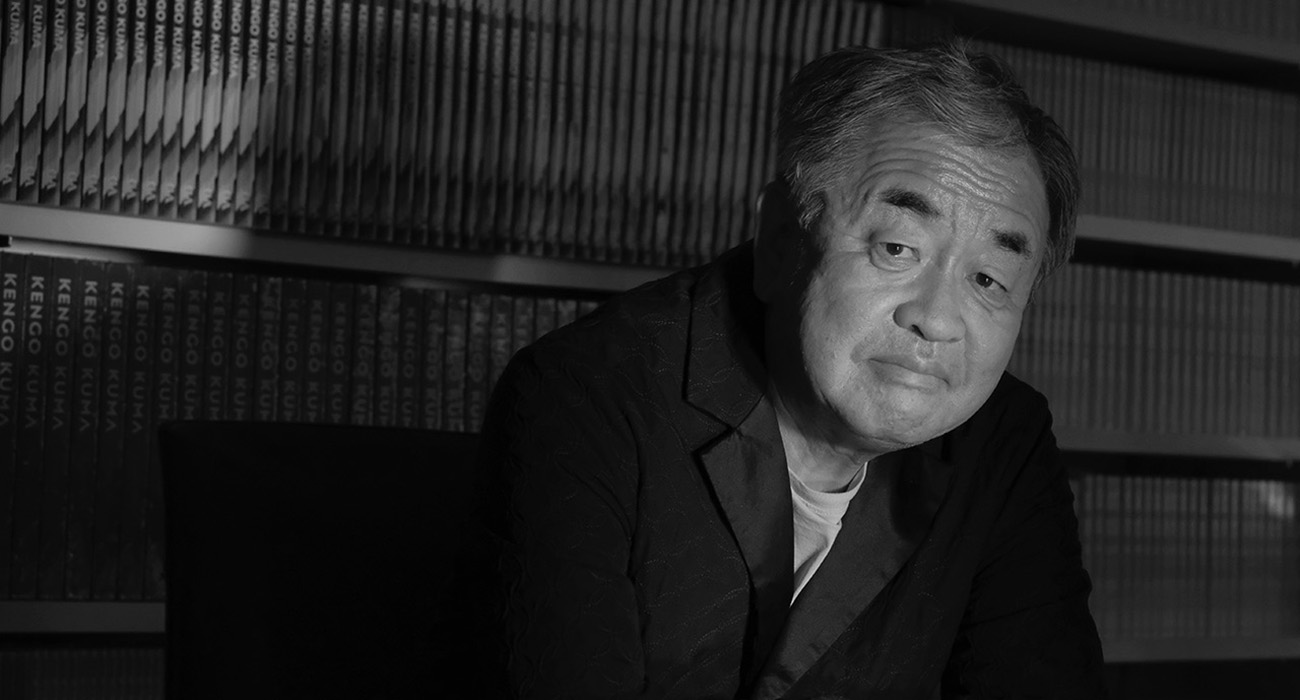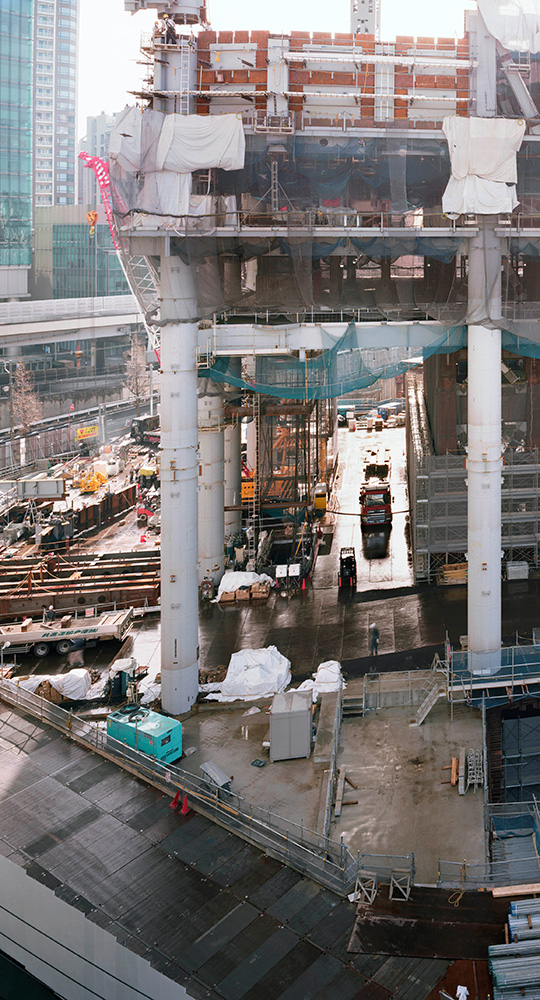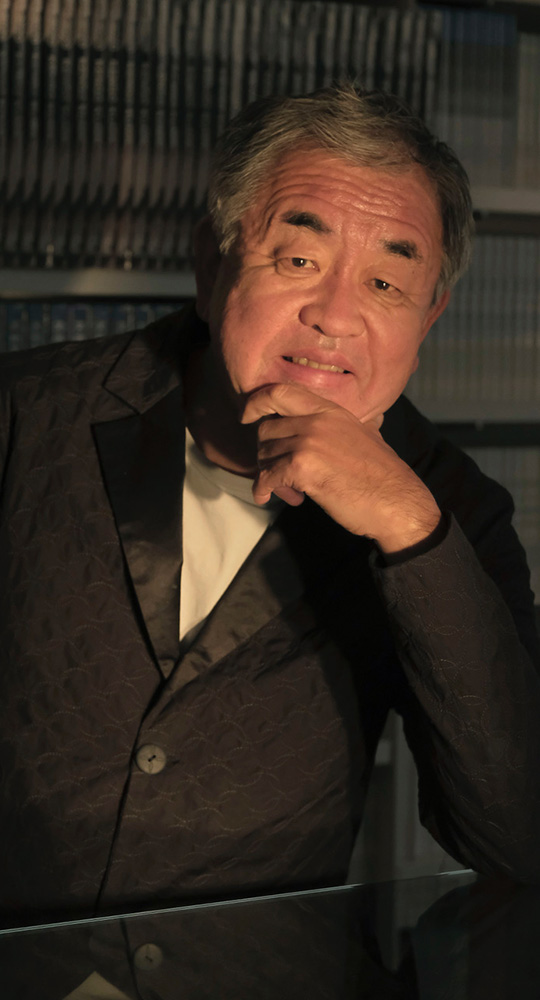
取材・テキスト:太田菜穂子 写真:広川泰士
既に2年余りとなる地球規模でのコロナ感染、この事態をどのように捉えていらっしゃいますか?
隈|
近年、僕らは日常の暮らしの安定を、その足元から掬われるような事態を経験してきました。2001年のアメリカの同時多発テロ「9.11」、そして2011年の東日本大震災「3.11」。これらは歴史の転換点という言葉で表現されきました。ただ、今回のそれは、これらとは次元の違うレベルでの危機感「自身の生存の危機」として、世界中の人がリアルタイムで経験し、切実な恐怖として受けとめています。現在の状況は、「歴史の転換点」ではなく、「歴史の折り返し点」、つまり僕たちは逆方向に歩き出す覚悟で臨む地点に立たされていると受け止めています。
多くの都市生活者が今回の事態で、コンクリートの高層ビルに押し込められ、そこで働くためには満員電車に詰め込まれる日々の息苦しさに気づき、疑問と恐怖を覚えたはずです。
人間らしく生きるための当然な欲求である感覚、たとえば季節の風を感じ、光を受けて呼吸する気持ちよさとは無縁となってしまった現在の都市空間。“何故ここまで、生物である人間が自分を虐待してまで都市で生きていかなければならないのか?”を誰もが自問したはずです。
電車通勤の必要性も、実際のところ、ICT(Information and Communication Technology 情報通信技術)を活用した働き方(リモートワーク)に切り替えることで解消され、永く謳われてきた高層ビルの「経済性と効率」も、まさに「フィクション(嘘)」に過ぎないことが明白になりました。もちろん20世紀初頭、大都会の中心部に建てられた高層ビルで働くべく、郊外に住む人々が通勤電車で通うという集中と移動が機能した時代があったことは事実です。
ただ、今回のコロナによって実施された「働き方のシフト」と『三密』を避けるための新しい日常生活のルールを通じて、「経済性と効率」の「嘘」に誰もが気づいてしまったのです。

広川泰士『BABEL』シリーズより


確かに、今回の世界各国で実施されたコロナ対策の過程を見ても、それぞれの国々の事情や国民性が炙り出された感があります。さらに主要国の大統領、首相、王族の感染や死亡のニュースに、身分や貧富の差など関係なく感染するウイルスの恐怖を人々は目の当たりにしました。
感染予防のキーワードとなった『三密(密閉・密集・密接)を避ける』は、生物であれば当然の生き方、自然との共生です。
隈|
今、僕たちは自然と共生する生き方を取り戻すため、「森に還る、自然に還る」ことが求められています。これからの建築は、人々が自然を感じる生活が送れる空間であるべきです。
本来建築とは、建築そのものが目立つ事ではなく、大切な何かを引き立てるために存在するべきです。そして、建築が引き立てて、最も映えるのは自然だと僕は思います。
建物と自然の調和という意味では、90年代に手がけられた栃木県那須町芦野の石の美術館「STONE PLAZA」(http://www.stone-plaza.com)に訪れた時の驚きは今でも忘れられません。水に囲まれた石蔵そのものの簡素な佇まいを周囲の自然が包み込み、那須という土地柄と歴史が凝縮しているようでした。
隈|
「STONE PLAZA」(http://www.stone-plaza.com)のプロジェクトは小予算で、周辺に「補助線となる装置」をつくることしかできませんでした。しかし、だからこそ、密閉型ではなく外気が行き交う解放された建築空間の創出ができました。予算が無かったからこそ、クライアントと僕たちはじっくり話し合い、目指すべきゴールとその意義を共有できました。20世紀型の外界を断絶するエアコン密閉型ではなく、内外が自然と共存し、石蔵の魅力を引き出す美術館を実現することに挑戦できたのです。



石蔵の周囲に水という「景観」を整備し、蔵に至る複数の「散歩道」で誘うような、様々な角度から風景としての建築を楽しみ、そして周囲の自然の美しさにも気づかせる、自然と調和した建築の在り様には、素直に心が解放されるような力を感じました。

How do you perceive our current situation, almost two years into the global pandemic?
Kengo KUMA (KK)|
In recent years, we have experienced situations where the stability of our daily lives has been uprooted. The ‘9.11’ terrorist attacks in 2001 in the USA, the ‘3.11’ Great East Japan Earthquake in 2011. These have been described using the phrase ‘tipping point in history’. However, this time people all over the world have experienced the pandemic in real time, a sense of crisis at a different level to these ‘tipping points’. A true ‘crisis of their own survival’, that they have perceived as a real and urgent fear. This current situation is not a ‘tipping point in history’, but a turning point, a point in time where we are prepared to walk in the opposite direction.
Many city dwellers will have been skeptical and frightened in the pandemic, recognizing the daily suffocation of being squeezed into concrete skyscrapers and packed into crowded trains to work there. Today’s urban space is far removed from the natural desire to live like a human being, for example by feeling the seasonal breeze and the feeling of bathing in and breathing light. Everyone should have asked themselves, “Why do human beings, living beings, have to live in the city to the point of abusing themselves?”
The need for commuting by train has actually been resolved by switching to a work style (remote work) that utilizes ICT (Information and Communication Technology), and the long-touted ‘economics and efficiency’ behind skyscrapers is nothing more than fiction.
Certainly there was a time in the early 20th Century when it worked, when the concentration and movement of people living in the suburbs to commute via trains to work in skyscrapers built in the center of the big cities worked. However, the new rules of daily life to change working styles and avoid the ‘3 Cs’ (closed spaces, crowded space and close-contact settings) implemented during the pandemic means everyone noticed the ‘lie’ of ‘economics and efficiency’.



Certainly, looking at the countermeasures brought in during the pandemic in each country around the world, I feel that the circumstances and national character of each country has been exposed. Furthermore, news of infections and deaths of Presidents, Prime Ministers and royalty in major countries around the world has borne witness to fear of a virus that infects people regardless of their status or wealth.
The key phrase in Japan of ‘Avoiding the 3 C’s’ to prevent infection is a natural way of life for a living being, coexisting with nature.
KK|
Currently, in order to regain a way of life in coexistence with nature, we are required to ‘return to the forest, return to nature’. Architecture in the future should be a space where people can live a life where they can feel nature.
Architecture should exist to enhance something important, not to make the architecture itself stand out. I think it’s natural that architecture complements its surroundings and makes it look its best.
In terms of harmony between buildings and nature, I still can’t forget my surprise when I visited the Stone Art Museum ‘STONE PLAZA’ (http://www.stone-plaza.com) in Ashino (Nasu town, Tochigi prefecture) in the 90s. The surrounding nature envelops the simple appearance of the stone building, surrounded by water, almost condensing the character of the land and history of Nasu.
KK|
The budget for ‘STONE PLAZA’ (http://www.stone-plaza.com) was small, and we could only build to ‘bring out the charms’ of the surrounding areas. However, this is also why we were able to create an open architectural space where the outside air flows in, rather than a closed style. Precisely because we didn’t have the budget, we were able to discuss with our clients and share mutual goals, and their meaning. Instead of a 20th Century air-conditioned closed space that cuts out the outside world, I was able to take on the challenge of realizing an art museum where the inside and outside spaces coexist with nature, bringing out the charm of the Stone museum.



Enjoying the architecture as scenery from various angles, such as creating a ‘landscape’ of water around the stone and inviting you in with various walkways leading up to it, while also making you aware of the beauty of the surrounding nature. I could truly feel the power of architecture in harmony with nature to open the heart.